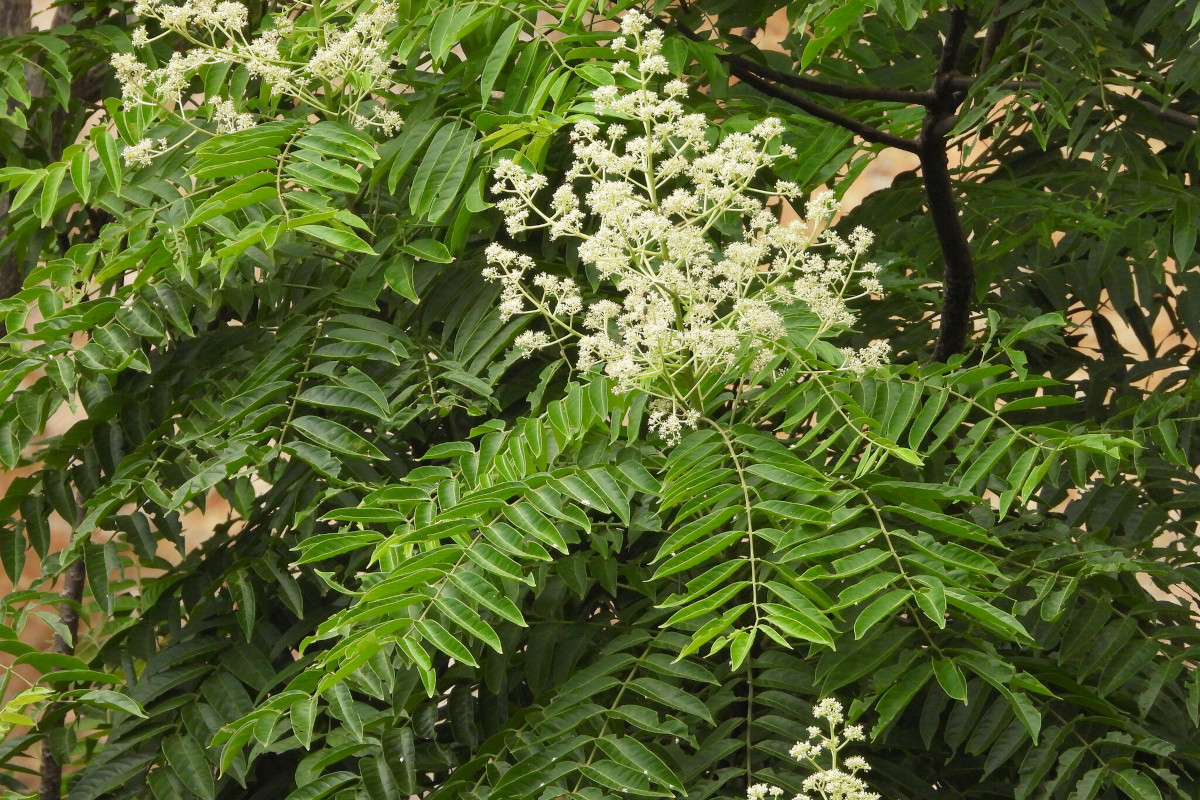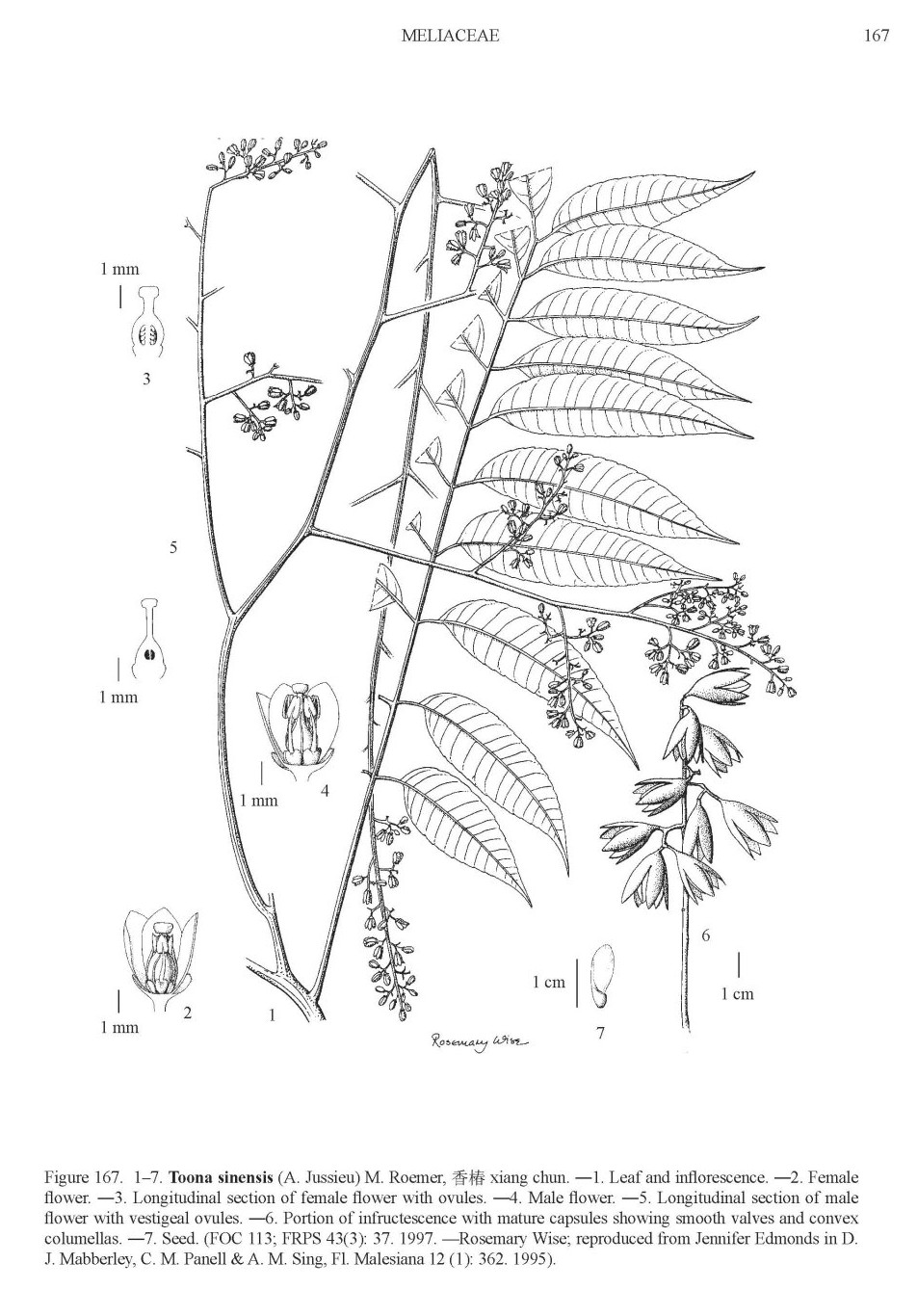Toona sinensis (A.Juss.) M.Roem. - syn.Cedrela sinensis A.Juss. - Meliaceae
香椿 xiang chun (chin.), red toon, Chinese mahogany, Chinese toon, Surenbaum
Deciduous tree, up to 40m (trunk 20m) tall, native to Southeast Asia (China to Malaysia) and India, cultivated as ornamental.
„…inner bark pink to red, fibrous; sap-wood cream-colored to red, fibrous, smelling strongly of garlic and pepper when cut…
The timber is used for furniture and sieve hoop-making, and in bridge construction. The leaves are used as a vegetable in China and Malaysia, and as animal fodder in India. The trees are widely used medicinally, with the bark being used as an astringent and depurative, powdered root as a refreshment and a diuretic, and tender leaves as a carminative.“
http://www.efloras.org/florataxon.aspx?flora_id=2&taxon_id=200012513
„The young leaves of T. sinensis (xiāngchūn) are extensively used as a vegetable in China; they have a floral, yet onion-like flavor, attributed to volatile organosulfur compounds.“ https://en.wikipedia.org/wiki/Toona_sinensis
The volatiles of the leaves of T.sinensis were analyzed with MAE-HS-SPME/GC-MS, and 45 compounds were identified (96% of the total chromatographic area). Trans-caryophyllene (21.4%), 2-hexenal (14.6%), 5-ethylthiazole (7.5%), 2,5-dimethylthiophen (4.2%), 1-methylimidazole-2-thione (3.6%), limonene (3.5%), β-eudesmol (2.6%), 1,7,7-trimethyl-2-vinylbicyclo[2.2.1]hept-2-ene (2.6%), 2-carene (2.3%), α-caryophyllene (2.1%) and β-elemene (1.9%) were the main components. Several kinds of low concentration terpenes and sulfur compounds like β-cedrene (1.5%), α-guaiaene (1.3%) and mintsulfide (0.2%) were also present.
[Rapid Determination of Volatile Compounds in Toona sinensis (A. Juss.) Roem. by MAE-HS-SPME Followed by GC-MS., Mu, R., Wang, X., Liu, S., Yuan, X., Wang, S., Fan, Z., Chromatographia, 65(7-8), 2007, 463-467]
Toona sinensis was found to contain norcysteine-containing metabolites like (S,S)-γ-glutamyl-(cis-S-1-propenyl)thioglycine, (S,S)-γ-glutamyl-(trans-S-1-propenyl)thioglycine, and γ-glutamyl-(cis-S-1-propenyl)-cysteine, which may release thiols via cleavage of the amide bond by proteases, followed by spontaneous decomposition of the resulting unstable alk(en)yl norcysteine moiety.
[Identification of (S,S)-γ-Glutamyl-(cis-S-1-propenyl)thioglycine, a Naturally Occurring Norcysteine Derivative, from the Chinese Vegetable Toona sinensis., Li, J.X., Eidman, K., Gan, X.W., Haefliger, O.P., Carroll, P.J., Pika, J., Journal of agricultural and food chemistry, 61(31), 2013, 7470-7476]
„The various parts tissues of this species are widely used in Traditional Chinese Medicine (TCM). The leaves and stems of this plant were used for the treatment of itch, dysentery, and enteritis. The bark was used as an astringent and depurative, the powdered roots were used as a corrective, and the fruits were used as an astringent and for the treatment of eye infections. Previous phytochemical investigations on this species have resulted in the isolation of flavonoids, phenolics, alkaloids, terpenes, anthraquinones, and limonoids. Besides its uses in TCM, the young leaves of T. sinensis (xiāngchūn) have been used extensively as a vegetable source in China for their special onion-like flavor and wealth of nutrients such as carotene and vitamins B and C, etc. The cultivated variety with red young leaves (Figure 1a) is considered of better flavour than those with green leaves.“
[Dong, Xiao-Jie, et al. „New limonoids and a dihydrobenzofuran norlignan from the roots of Toona sinensis.“ Molecules 18.3 (2013): 2840-2850] http://www.mdpi.com/1420-3049/18/3/2840/htm

Toona sinensis, Na Ngua, Nam Som District, Thailand (2022) © Utain Pummarin CC BY-SA 4.0 inaturalist.org

picture source: Flora of China, Harvard, http://www.efloras.org/object_page.aspx?object_id=109710&flora_id=2
